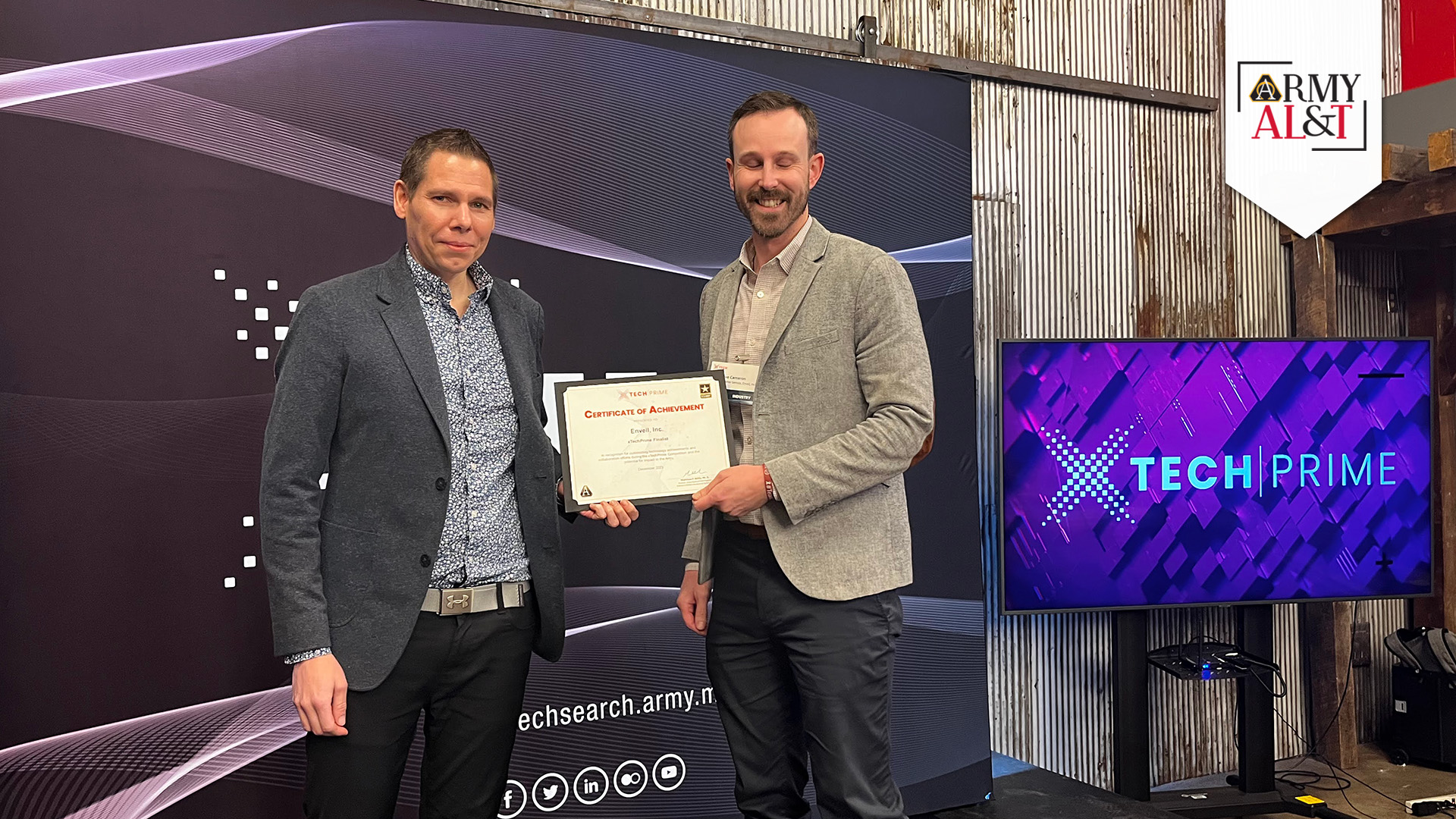
TAKING FIRST PLACE: Matt Willis, Ph.D., left, director of Army Prize Competitions and Army SBIR Program, awards Steve Cameron, Enveil, Inc. chief of customer service, a first-place award for xTechPrime’s Project Linchpin topic area. (Photo provided by U.S. Army xTech Program)
Army SBIR and xTech prize competitions are partnering with Project Linchpin to scale artificial intelligence solutions.
by Anna Volkwine and Steven Lusher
The development of advanced artificial intelligence (AI) solutions from industry provides the Department of Defense with opportunities to enhance and strengthen its strategic edge in national defense. As these technologies evolve, the U.S. Army Small Business Innovation Research (SBIR) and xTech Programs play a vital role in delivering these innovative AI solutions to the Army.
Led by the Office of the Assistant Secretary of the Army for Acquisition, Logistics and Technology, the programs offer innovators research and development funding to tackle critical challenges. Via the Army SBIR Program, the assistant secretary of the Army for acquisition, logistics and technology (ASA(ALT)) offers small businesses opportunities to demonstrate solutions that show technical merit, feasibility and commercial potential. The program invests over $350 million per year in small businesses across the country in non-dilutive funding—funding that does not require a business to give up equity of the company—to transition technologies to Soldiers.
The xTech Program uses a prize competition model to foster collaboration between the Army and nontraditional innovators including small businesses, academia, international innovators and more. XTech competitions offer non-dilutive cash prizes, along with feedback, mentorship and networking opportunities with Army customers. XTech competition winners may also receive opportunities for follow-on contracts, such as Army SBIR awards.
When it comes to AI, Army SBIR and xTech are just the tip of the spear for identifying and integrating cutting-edge solutions. The programs continuously optimize partnerships with other innovation-driven Army organizations, including Project Manager Intelligence Systems and Analytics (PM IS&A), which focuses on AI delivery via Project Linchpin. PM IS&A is responsible for critical Army modernization initiatives such as Army Intel Data Platform and Tactical Intelligence Targeting Access Node, and falls under Program Executive Office Intelligence, Electronic Warfare and Sensors (PEO IEW&S).
PM IS&A partnered with Army SBIR and xTech to develop the operational data, policies and trusted infrastructure to deploy and field AI applications via Project Linchpin. The collaboration seeks to deliver game-changing AI technologies across the PEO IEW&S portfolio.
“Project Linchpin is building an operational pipeline of trusted AI solutions, aligning with the Army’s broader AI implementation,” said Col. Chris Anderson, project manager, PM IS&A. “This plan aims to deliver a coherent approach to AI across the Army, with specific execution windows for integrating complex AI efforts.”

SHOWCASING AI CAPABILITIES: Small business Latent AI was a winner in the U.S. Army xTechPrime competition for the Project Linchpin topic area. Honson Tran, left, developer experience lead at Latent AI, met with Young Bang, ASA(ALT) principal deputy, at the 2024 GTC AI conference in San Jose, California in March 2024, to demonstrate the winning Latent AI Efficient Interference Platform. (Photo courtesy of Latent AI)
COMBINING FORCES
Capitalizing on the unique strengths of the Army SBIR and xTech Programs, Project Linchpin accelerates the research and development of innovative AI technologies for defense applications. As an Army transition partner, PEO IEW&S and its project managers, including PM IS&A, benefit from access to innovative solutions from the private sector. Meanwhile, the Army SBIR and xTech Programs provide a pathway for transitioning technologies into the Army’s operational framework.
“Collaboration between Army programs is critical because it looks at solving Army challenges very holistically,” said Matt Willis, Ph.D., director of Army Prize Competitions and the Army SBIR Program. “The adoption of AI requires an end-to-end perspective that will enable the Army to do this expeditiously, while navigating around associated risks.”
Willis’ sentiment rings true for Project Linchpin and ASA(ALT)’s innovation-centric programs. Project Linchpin focuses on the infrastructure, standards, governance and processes behind AI adoption. Combined with the flexibility and creativity of nontraditional innovators through Army SBIR and xTech, the Army seeks to lead in AI implementation with options to accelerate funding and technology transition.
For example, in fiscal year 2024, Army SBIR invested nearly $10 million in five small businesses aligned to Project Linchpin thrust areas. For fiscal year 2025, this number is projected to increase. Army SBIR estimates $45 million in contract awards for Project Linchpin, out of an estimated $114 million in awards for Army SBIR’s larger artificial intelligence/machine learning (AI/ML) portfolio, which focuses on solicitations aligning to other potential transition partners on top of Project Linchpin’s thrust areas.
Part of this funding stems from current and future Army SBIR awards made via xTech competitions that have Project Linchpin-specific focus areas, putting innovation into action for the Army.
“Through the Army SBIR and xTech Programs, Project Linchpin serves as a cornerstone for the Army’s efforts to harness AI at scale, ensuring that the solutions are secure, trusted and effectively integrated into military applications,” Anderson said.

SMALL BUSINESS CONNECTIONS: Enveil Inc., a winner of xTechPrime for the Project Linchpin topic area, attended the xTech Collider in Austin, Texas in August 2023, where technology integrators had the opportunity to network with small businesses from the xTechPrime competition. (Photo courtesy of U.S. Army xTech Program)
INNOVATION IN ACTION
Launched in spring 2023, xTechPrime served as a unique competition model that combined the flexibility and ingenuity of small businesses with the resources and expertise of technology integrators. xTechPrime is an example of how the Army can tailor their competition models so that PEOs and program managers can accelerate the development of technologies through Army SBIR and xTech.
Fifteen xTechPrime winners received $40,000 in cash prizes and submitted a Direct to Phase II Army SBIR contract worth up to $2 million. The competition addressed various topics that impact Army readiness; notably, PM IS&A supported a Project Linchpin topic to provide small businesses a chance to showcase their innovative technology solutions.
Latent AI and Enveil, Inc., alongside their respective technology integrators, Booz Allen Hamilton and RTX Corporation, won for the Project Linchpin topic. This win facilitated crucial Army connections, cash prizes and an Army SBIR Direct to Phase II contract award to prove the technology feasibility for its Project Linchpin application. “Project Linchpin leverages xTech and Army SBIR Programs to explore innovative technologies from small businesses, and does so in a very focused, rapid manner,” said Sek Chai, Ph.D., Latent AI co-founder and chief technology officer. “XTechPrime, for example, is structured to consider how technology is evaluated and integrated into current infrastructure and workflow.”
Ellison Anne Williams, founder and CEO of Enveil, Inc., noted that nontraditional innovators are leveraging the power of transformative capabilities without compromising mission interests.
“Project Linchpin is dedicated to advancing the Army’s AI/ML efforts in a secure, trustworthy, sustainable way, and we are proud to be working in support of this initiative by delivering capabilities that showcase the broad, mission-enabling impact of privacy enhancing technologies,” she said.
In addition to xTechPrime, xTech launched two additional AI-specific competitions in fiscal year 2024. In late 2023, Young Bang, ASA(ALT) principal deputy, requested that Willis and his team utilize the prize competition structure to seek solutions from small businesses to defend against adversarial AI threats. XTechScalable AI launched in December 2023, and xTechScalable AI 2 launched quickly thereafter in March 2024 to continue fueling the Project Linchpin pipeline of tools and services. The range of solutions received from these competitions highlights how ASA(ALT)’s vision can pair with Army programs to nurture scalable, commercial AI solutions from small businesses.
“Project Linchpin plays a pivotal role in the Army’s efforts to scale AI capabilities, particularly through the collaboration with the Army SBIR and xTech Programs,” Anderson said. “For instance, the xTechScalable AI 2 competition aligns to Project Linchpin’s core needs and has provided a range of commercial solutions that each have the potential to be a critical part of the Army’s strategy to deliver trusted AI.” Anderson concluded by noting that as AI innovation continues to evolve, Project Linchpin hopes to further partnerships with Army SBIR and xTech to grow its portfolio of possibilities.
Looking ahead, the Army plans to launch more AI-focused competitions in fiscal year 2025. These competitions consist of multiple Technical Grand Challenges, as well as open-topic Army SBIR solicitations, to continue driving AI innovation. The Technical Grand Challenges, directed by ASA(ALT), are associated with Project Linchpin and the open-topic competitions are designed to explore the “realm of the possible” and include AI-specific focus areas or solutions.
CONCLUSION
The Army SBIR and xTech Programs remain committed to partnerships that span innovation ecosystems, support Army organizations buy down risk and discover what is possible within industry’s innovation ecosystem. To match the speed and flexibility of small and nontraditional businesses, the programs find and mature transformative technologies—providing an agile pathway to integration into critical Army systems where larger processes struggle.
At the heart of the programs lies the ultimate commitment to support the Soldier. Army organizations with the same commitment can leverage the programs to reduce risk, tap into the innovation ecosystem and utilize a fast-tracked acquisition strategy. By transitioning innovative and emerging technologies into practical applications, these collaborations equip the Soldier with cutting-edge capabilities that bring a strategic advantage to the battlefield.
Army SBIR and xTech aim to achieve the possible. Partnerships with decisive Army partners, such as PM IS&A and Project Linchpin that are driving innovation, are an example of what possible can look like. Now is the time to consider what future innovation could look like for other Army partners.
For more information on the Army SBIR Program, go to www.armysbir.army.mil. To learn more about the xTech Program, go to www.xtech.army.mil.
ANNA VOLKWINE provides contract support to the Office of Army Prize Competitions and Army SBIR Program for Booz Allen Hamilton. She holds a B.A. in strategic communications from Mount St. Mary’s University.
STEVEN LUSHER provides contract support to the Office of Army Prize Competitions and Army SBIR Program for Booz Allen Hamilton. He holds an MBA in marketing and strategic communications from The University of Phoenix.
XTECH FINALISTS MAKE SCALABLE AI AN ARMY REALITY
The U.S. Army xTech Program launched two AI-specific prize competitions in fiscal year 2024, supported by the PM IS&A and its modernization initiative, Project Linchpin. Matt Willis, Ph.D., director of Army Prize Competitions and Army SBIR Program, and his team launched xTechScalable AI in December 2023 for small businesses to develop comprehensive, scalable models capable of defending against universal AI threat vectors. The competition offered a total prize pool of $370,000 and up to $8 million in follow-on Army SBIR contract awards to small businesses across the U.S.
XTechScalable AI 2 launched just months later in March 2024, with three topic areas in support of Project Linchpin, including: scalable tools for automated AI risk management and algorithmic analysis; scalable techniques for robust testing and evaluation of AI operations pipelines; and scalable techniques for center of mass and course of action analytics for intelligence preparation of the battlefield. The second iteration offered up to $603,000 in cash prizes and opportunities to submit proposals for a Phase I or Phase II Army SBIR contract valued at up to $250,000 or $2 million, respectively.
Read on to meet the competitions’ 24 finalists and get a glimpse into xTech’s world of innovation.

SCALABLE AI: XTechScalable AI launched in December 2023 to better understand the spectrum of commercial solutions that could enhance the Army’s security capabilities in AI and ML. (Photos courtesy of U.S. Army xTech Program)
THE TOP 8: XTECHSCALABLE AI FINALISTS
The program announced the xTechScalable AI winners in July 2024. Head over to the competition page of the xTech website to see who made the final cut.
Ad hoc Research. Adaptive AI Testing and Transparency: Unveiling DarkStax, the Future of Digital Twin Simulations in Military AI: Enhances AI systems’ resilience against cyber threats by simulating and testing AI behaviors in diverse scenarios, ensuring robustness and reliability.
BlueRiSC, Inc. AI Defense in Depth Architecture: Addresses threats in AI-based systems with modules for both prevention and detection, resulting in a comprehensive solution.
dMetrics. Transparent, Customizable and Traceable Information Extraction from Large Textual Sources: Learning platform built for non-technical experts, removing the need for coding or technical personnel and empowering analysts to read at scale through their own lens.
Eduworks. Lorica: AI Agent Microservices for Federated Data Security: Protects sensitive data and ML pipelines using a cluster of scalable, task-specific AI micromodels that can be deployed to detect adversarial attacks.
Expression Networks, LLC. TRUST-Large Language Model Operations (LLMOps) for the Army: Provides a data-, model- and vendor-agnostic solution to the challenges of LLMOps securely unleashing data intelligence at speed and scale.
Infleqtion. Secured AI for Positioning at the Edge, Navigation and Timing: Defends AI/ML systems against adversarial AI attacks, specifically targeting positioning, navigation and timing vulnerabilities, by fusing diverse data sources to identify and react to attacks.
Latent AI. Composable Hybrid Ensembles for Rapid AI Adaptation: Empowers developers with easy-to-use recipes to rapidly adapt AI models that are optimized and secured to address unknown attacks and vulnerabilities.
Quartus Engineering. Quartus Data Audit Tool: Enhances the data labeling and dataset management process, utilizing ML Zero-Shot technology to confirm datasets are reliable and recommend adjustments for faulty labels.

SCALABLE AI 2: XTechScalable AI 2 launched in March 2024 as the follow-on competition to xTechScalable AI, with focus areas aligned to Project Linchpin.
THE TOP 16: XTECHSCALABLE AI 2 FINALISTS
The xTechScalable AI 2 finals event will be held at the Association of the United States Army 2024 Annual Meeting and Exposition in October, and the winners will be posted to the xTech website shortly thereafter.
Anaconda, Inc. Rasterizing Large Datasets for Course of Action (CoA) Support: Allows large data sets to be rendered directly onto the screen by aggregating data points per pixel on the display device, providing complete context for decision makers choosing CoA in the field.
Cenith Innovations LLC. AI-Enabled, Automated CoA Generation and Threat Visualization for Intelligence Preparation of the Battlefield (IPB): Provides faster and more accurate IPB, empowering leaders to understand the terrain, routes and plans necessary for complex obstacle breaching.
ColdQuanta, dba Infleqtion. Consolidating Locations of Enemy Unit Symbols with AI in Real Time for Visualization: Creates a concise, common operating picture, capitalizing on the widespread availability of computing resources to deliver physics-based map solutions to Soldiers.
Credo AI. The Credo AI Governance Platform to Enable Army Adoption of an AI Risk Management Framework: Purpose-built for AI governance, providing a command center for end-to-end Governance, Risk and Compliance for AI systems.
DynamoFL. Scalable AI Testing to Identify and Mitigate Generative AI Model Vulnerabilities: Assists in incorporating secure, private and compliant AI into operations, including AI system evaluations, model enhancement, risk remediation and system guardrails development with real-time observability.
Latent AI. Battle-Management of Edge AI T&E: Supports automated test and evaluation of data, training labels, model training, and AI runtime deployment, enabling fast and robust fielding time of model updates.
Next Tier Concepts Inc. Nights Watch: Protecting the Army’s AI while the Army Protects America: Serves as a test harness and monitoring system to assess AI models robustness to natural and adversarial phenomena prior to model deployment.
Phoenix Operations Group. Center-of-Mass (CoM) and CoA Validation Analytics: Provides Intelligence Preparation of the Battlefield analytics for CoM calculations and CoA validation, using ML techniques implemented with open-source libraries and will integrate with existing technology stacks.
Protopia AI. Privacy Enhancement and Data Protection for Gen AI and LLMs using Stained Glass Transform: Protects data and preserves privacy by allowing AI algorithms to operate accurately without exposing raw sensitive information, unlocking the data-secure development and deployment of AI systems to enhance security.
Pytho AI. Intelligent and Interactive Battlespace Visualizations Powered by Mixture of Experts AI System: Reduces cognitive burden as an interactive battlespace visualization and analytics platform, with disruptive intelligence models and an intuitive user interface.
R-DEX Systems, Inc. Wayfarer: Real-time Data Drift and Out of Distribution (OOD) Detection Package: Streamlines the process of keeping ML models aligned with production data by focusing on OOD samples, minimizing the labeling workload for analysts and ensuring models remain accurate over time.
Senix Robotics LLC. Multi-Layered AI Approach for Scalable Battlefield Intelligence and Decision Making: Addresses data overload and inefficient manual processes, using advanced ML and generative AI to process sensor inputs, cluster data and provide strategic analysis.
Striveworks. Valor: A Platform- and Model-Agnostic Evaluation Store: Simplifies and standardizes T&E, making it easy to measure, explore and rank model performance, working with any dataset, model or metadata.
Trail of Bits. ModelInspector: Detecting AI/ML Model Weaknesses via Bill-of-Materials (AIBOM) Based Analysis: Creates, maintains and assesses a system’s AIBOM for weaknesses, and creates AIBOMs for systems and then analyzes them to detect data drift, data leakage risks and susceptibility to adversarial threats.
Valkyrie Intelligence. Robust AI Operations Testing Suite for Defense Applications: Assesses data integrity, monitors data label accuracy, and evaluates model robustness for various AI/ML pipelines while detecting, alerting and remediating adversarial attacks.
Walacor Corporation. Walacor: Built on blockchain/distributed ledger technology, improves MLOps by ensuring provable data immutability, auditability and element-level encryption.

LET’S TALK AI: Small businesses have entered the conversation on AI innovation via the xTechScalable AI and xTechScalable AI 2 prize competitions. With the first iteration underway, xTech and Project Linchpin leadership announced xTechScalable AI 2 at the SXSW conference in Austin, Texas in March 2024.







